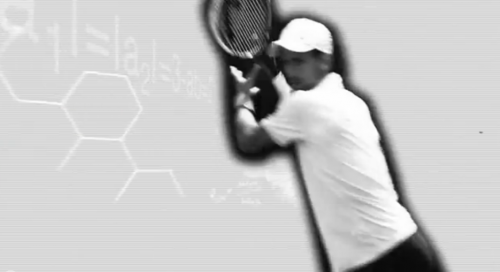By Matin Durrani

Novak Djokovic uses a Head tennis racket containing graphene.
It has become a cliché to call graphene the “wonder material” because of its incredible physical and electronic properties – this 2D honeycomb of carbon atoms is not only the strongest ever discovered, but also the stiffest, being able to sustain a current density a million times that of copper.
Having such great attributes is all well and good if you’re a researcher who’s fascinated by the subtleties of graphene’s electronic properties such as its lack of a band gap – but what if you’re a hard-nose business executive? Graphene will only be any good if it can help you to sell a product that’s somehow better than what’s already on the market and if it can at also make the company money at the same time.
That matter-of-fact thinking was very much to the fore at a meeting in London this week called the Graphene Commercialisation and Applications summit. It brought together nearly 150 senior research executives, academics and industry leaders to discuss how graphene can be turned into real money-making products.
Among those who spoke was Michael Balthasar, director of new technologies and innovation at Volvo Advanced Technology and Research. It might at first sight seem odd that a truck-building company should be interested in graphene, but just imagine if this ultrathin material could be included in flexible displays that could literally be moulded into the vehicle’s dashboard or windscreen. Or if graphene could be introduced into a vehicle’s brake pads to quickly extract the heat generated from friction when a lorry slows down.
Another speaker was Gareth Williams, vice-president of research and technology at Airbus. This European plane-making consortium is actively looking at the benefits of graphene and Williams highlighted any plane manufacturer’s obvious priority to ensure that its craft are not only safe but also as light as possible. Fuel, after all, is expensive and if graphene can help to shave off even a few percent of a plane’s mass, the benefits could be huge. But as Marcello Grassi, head of technology at Spirit AeroSystems Europe, pointed out, one promising application of graphene could actually be to help dissipate the current from lightning strikes, which is currently done using relatively heavy copper mesh.
There were also talks from industry chiefs at the likes of Philips Research (using graphene to make ultrasensitive photon detectors) and Nokia (as an ultra-transparent and bendable conductor on touch-screen smartphones), but probably what got delegates most excited during the coffee breaks was a presentation by Ralf Schwenger, a research director at Head Sport – an Austrian company that makes and sells some 200,000 tennis racquets a year.
Head Sport already uses graphene as a material in the frame of its YouTek™ Graphene™ racquets – the material acts as filler that can be added in such a way that less of the racquet mass lies in the middle part of the racquet, with more in the grip of the shaft and also in the racquet’s head. According to the company’s website, this “unique construction provides players with an unmatched manoeuvrability and an increased swing weight”. Essentially, a Graphene racquet “is easier to swing and enables even more powerful shots”.
I’m slightly concerned that the company appears to have trademarked the name Graphene to describe its racquets – I’m not sure what graphene leaders Andre Geim and Konstantin Novoselov, who won the 2010 Nobel Prize for Physics, will make of that. But what’s interesting is that you can already buy Graphene racquets from Head – in fact, Andy Murray, Novak Djokovic and other tennis stars are already using them at this year’s Wimbledon Championships.
But what everyone at the meeting pointed out is that graphene will only ever enter the mainstream if there is a proper “graphene ecosystem” – in others words, we need companies that can make graphene of the right quality and amount, killer applications that create a demand, and the right graphene know-how so that the knowledge about this material can be transferred out of the laboratory and into real products. After all, there have been plenty of other exciting products and innovations over the years that have not yet at least really taken off commercially. (Fuel cells anyone?)
I’m optimistic though that graphene will eventually make the grade and if Andy Murray or Novak Djokovic wins Wimbledon, surely that’s got to give this wonder material a massive boost.
For more on graphene, check out this month’s Physics World Focus Issue on Nanotechnology, which includes a feature by Kostya Novoselov on the new National Graphene Institute at the University of Manchester.
The graphene electronic side will be the decisive factor and not the tennis racquets that may run to a few thousands at the most.
Are you kidding? Of course one of those two will win Wimbledon, but they were also winning before they were using graphene racquets, weren’t they?
Now, it would be a good advertisement if HEAD just picked up a random guy off the street, gave him the racquet, and he won the Wimbledon
Remarkable things here. I’m very happy to look your article. Thank you a lot and I’m having a look ahead to contact you. Will you please drop me a mail?
Trackback: Graphene Commercialization & Applications 2013, Dec. 10-11, San Mateo, CA | Graphene Stakeholders Association